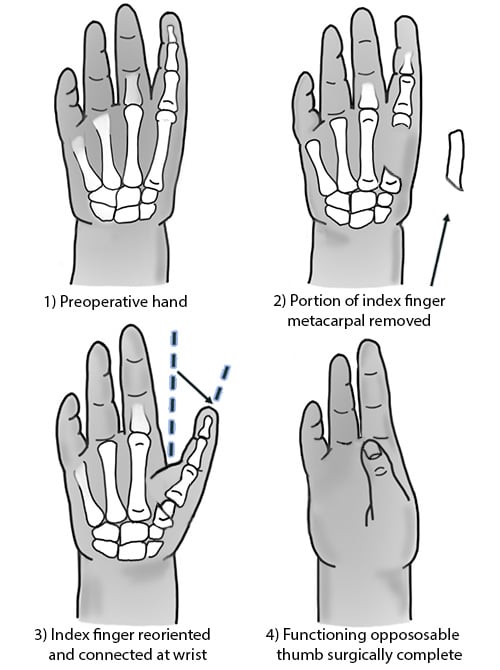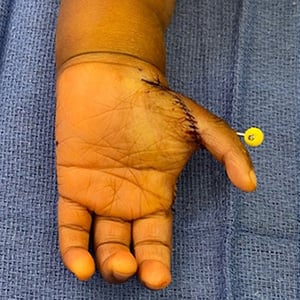Pollicization: Orthopedic Surgery to Construct a Missing Thumb
What is pollicization surgery?
When a child is missing a functional thumb, the surgery to build a thumb out of an index finger is called index pollicization. Pollicization requires shortening, angulation, and rotation of the index finger to put it in a thumb position away from the other fingers. Tendons and muscles also have to be rearranged to allow the index finger to move like a thumb.
When is toe-to-thumb transfer performed instead of pollicization surgery?
Toe-to-thumb is always an option for creating a new thumb, and the advantage over pollicization is that it maintains five digits in the hand. However, using a toe requires having nerves and muscles that can be borrowed from the hand to make the new thumb move and feel like a regular thumb. It also requires a place to anchor the new thumb. For these reasons, toe-to-thumbs are best for traumatic amputations or congenital amputations where the base of the thumb is intact.
How is a missing or deficient thumb constructed?
In many ways, the thumb is a finger that has lost its metacarpal and is therefore shorter. The metacarpal bones are the bones in your hand. The joint at the base of your thumb is a modified knuckle joint, and the two joints in the thumb are similar to the two joints in your fingers.
Pollicization shortens the index finger by removing most of the metacarpal bone. The knuckle joint becomes the joint at the base of the new thumb, allowing the new thumb to have circular motion similar to a regular thumb. The muscles in the hand that go to the index finger are then moved up one joint to allow the new thumb to be powered like a thumb. Finally, the skin is rearranged to create the appearance of a thumb by filling in the space between the fingers and the thumb.

Are multiple surgeries required to make a working thumb?
Pollicization takes under two hours to perform, and revisions are rarely needed. It is unusual for a child to require a second surgery.
What type of doctor does pollicization surgery?
Pollicization is a complicated operation, and each step must be performed perfectly for the operation to work. Even when everything is done precisely, complications and less than optimal outcomes can occur. Make sure your surgeon has completed a pediatric hand surgery fellowship and is proficient in performing a pollicization.
Will a child’s new thumb continue to grow?
Yes. Unless there is a complication, the new thumb will grow to keep up with the rest of the hand. In fact, too much growth is more common than too little.


What is the right age for a child to have pollicization surgery?
While there is no age limit, we prefer to perform a pollicization before the child reaches pre-school age so that they can learn to use their hand as it is going to be for the rest of their lives. The minimum age is typically 18 months.
Is pollicization surgery different for adults versus children?
There are slight differences, but the operation is essentially the same. Adults require shortening of the tendons to the new thumb, whereas children will shorten them on their own over time.
What are the advantages and disadvantages in pollicization surgery?
Pollicization creates the best looking and best functioning thumb compared to all other techniques out there. The only disadvantage is that the index finger needs to be used. Toes do not look as good and do not function as well. Reconstructions using other parts from the toes and tendon transfers also are inferior. Prosthetics are limiting because they are stiff and have no sensation.
What are the risks in pollicization surgery?
The biggest risk, which is rare and has never happened at our institution, is loss of the new thumb. Other more common risks are stiffness of the new thumb, too long or too short a thumb, overgrowth of the thumb, scarring around the thumb, and infection.
What is the recovery like after for pollicization surgery?
The child is placed in a cast for four weeks after surgery. The cast is then removed, and 3 to 5 days of intensive therapy are done to get the thumb moving. This is followed by an additional two months of therapy twice a week along with a splint to be worn at night and when at risk of injury.
How soon can you put weight on you hand after pollicization surgery?
The thumb can be used as soon as the cast is removed four weeks after surgery. We recommend light use until eight weeks after surgery, when strengthening can begin.
How do you learn to use the new thumb?
Children who do not have a working thumb naturally learn to use their index finger as their substitute thumb even before surgery. Pollicization just makes it a better substitute thumb. The therapy is really to get the tendons and muscle moving and prevent injury as everything is healing.
Video: After Pollicization Surgery
This video shows a young boy demonstrating his opposable thumb after undergoing pollicization surgery.
References
- Donohue KW, Zlotolow DA, Kozin SH. Long-finger pollicization for macrodactyly of the thumb and index finger. J Pediatr Orthop. 2014 Oct-Nov;34(7):e50-3. doi: 10.1097/BPO.0000000000000232. PMID: 24919138.
- Soldado F, Zlotolow DA, Kozin SH. Thumb hypoplasia. J Hand Surg Am. 2013 Jul;38(7):1435-44. doi: 10.1016/j.jhsa.2013.03.021. Epub 2013 May 21. PMID: 23702392.
- Zlotolow DA, Tosti R, Ashworth S, Kozin SH, Abzug JM. Developing a pollicization outcomes measure. J Hand Surg Am. 2014 Sep;39(9):1784-91. doi: 10.1016/j.jhsa.2014.06.018. Epub 2014 Aug 1. PMID: 25091337.

